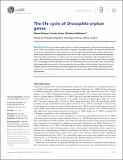Files in this item
The life cycle of Drosophila orphan genes
Item metadata
| dc.contributor.author | Palmieri, Nicola | |
| dc.contributor.author | Kosiol, Carolin | |
| dc.contributor.author | Schlötterer, Christian | |
| dc.date.accessioned | 2017-02-09T13:30:25Z | |
| dc.date.available | 2017-02-09T13:30:25Z | |
| dc.date.issued | 2014-02-19 | |
| dc.identifier | 249098762 | |
| dc.identifier | 37009f2f-69a2-4a1a-8848-bd04677bb10d | |
| dc.identifier | 24554240 | |
| dc.identifier | 84896504155 | |
| dc.identifier.citation | Palmieri , N , Kosiol , C & Schlötterer , C 2014 , ' The life cycle of Drosophila orphan genes ' , eLife , vol. 3 , e01311 . https://doi.org/10.7554/eLife.01311 | en |
| dc.identifier.issn | 2050-084X | |
| dc.identifier.other | PubMedCentral: PMC3927632 | |
| dc.identifier.uri | https://hdl.handle.net/10023/10259 | |
| dc.description | Funding: Austrian Science Funds (FWF) (P22834). | en |
| dc.description.abstract | Orphans are genes restricted to a single phylogenetic lineage and emerge at high rates. While this predicts an accumulation of genes, the gene number has remained remarkably constant through evolution. This paradox has not yet been resolved. Because orphan genes have been mainly analyzed over long evolutionary time scales, orphan loss has remained unexplored. Here we study the patterns of orphan turnover among close relatives in the Drosophila obscura group. We show that orphans are not only emerging at a high rate, but that they are also rapidly lost. Interestingly, recently emerged orphans are more likely to be lost than older ones. Furthermore, highly expressed orphans with a strong male-bias are more likely to be retained. Since both lost and retained orphans show similar evolutionary signatures of functional conservation, we propose that orphan loss is not driven by high rates of sequence evolution, but reflects lineage-specific functional requirements. | |
| dc.format.extent | 21 | |
| dc.format.extent | 13050622 | |
| dc.language.iso | eng | |
| dc.relation.ispartof | eLife | en |
| dc.subject | QH301 Biology | en |
| dc.subject | QH426 Genetics | en |
| dc.subject | BDC | en |
| dc.subject | R2C | en |
| dc.subject.lcc | QH301 | en |
| dc.subject.lcc | QH426 | en |
| dc.title | The life cycle of Drosophila orphan genes | en |
| dc.type | Journal article | en |
| dc.contributor.institution | University of St Andrews. School of Biology | en |
| dc.contributor.institution | University of St Andrews. Centre for Biological Diversity | en |
| dc.identifier.doi | 10.7554/eLife.01311 | |
| dc.description.status | Peer reviewed | en |
This item appears in the following Collection(s)
Items in the St Andrews Research Repository are protected by copyright, with all rights reserved, unless otherwise indicated.

